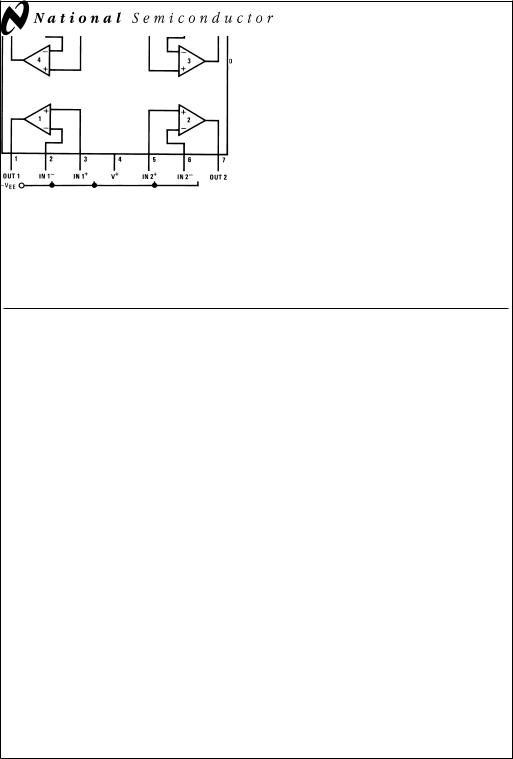NSC LF444MWC, LF444MD-883, LF444CN, LF444CMX, LF444CM Datasheet

May 1998
LF444
Quad Low Power JFET Input Operational Amplifier
General Description
The LF444 quad low power operational amplifier provides many of the same AC characteristics as the industry standard LM148 while greatly improving the DC characteristics of the LM148. The amplifier has the same bandwidth, slew rate, and gain (10 kΩ load) as the LM148 and only draws one fourth the supply current of the LM148. In addition the well matched high voltage JFET input devices of the LF444 reduce the input bias and offset currents by a factor of 10,000 over the LM148. The LF444 also has a very low equivalent input noise voltage for a low power amplifier.
The LF444 is pin compatible with the LM148 allowing an immediate 4 times reduction in power drain in many applications. The LF444 should be used wherever low power dissipation and good electrical characteristics are the major considerations.
Features
n1¤4 supply current of a LM148: 200 µA/Amplifier (max)
nLow input bias current: 50 pA (max)
nHigh gain bandwidth: 1 MHz
nHigh slew rate: 1 V/µs
nLow noise voltage for low power
nLow input noise current
nHigh input impedance: 1012Ω
nHigh gain VO = ±10V, RL = 10k: 50k (min)
Simplified Schematic |
Connection Diagram |
1/4 Quad |
Dual-In-Line Package |
DS009156-2
|
DS009156-1 |
Top View |
|
|
|
Ordering Information |
|
Order Number LF444AMD, LF444CM, |
|
LF444ACN, LF444CN or LF444MD/883 |
|
LF444XYZ |
|
|
|
See NS Package Number D14E, M14A or N14A |
X indicates electrical grade
Y indicates temperature range
ªMº for military, ªCº for commercial
Z indicates package type ªDº, ªMº or ªNº
BI-FET™ and BI-FET II™ are trademarks of National Semiconductor Corporation.
Amplifier Operational Input JFET Power Low Quad LF444
© 1999 National Semiconductor Corporation |
DS009156 |
www.national.com |

Absolute Maximum Ratings (Note 11)
If Military/Aerospace specified devices are required, please contact the National Semiconductor Sales Office/ Distributors for availability and specifications.
|
LF444A |
|
LF444 |
Supply Voltage |
±22V |
|
±18V |
Differential Input Voltage |
±38V |
|
±30V |
Input Voltage Range |
±19V |
|
±15V |
(Note 1) |
|
|
|
Output Short Circuit |
Continuous |
Continuous |
|
Duration (Note 2) |
|
|
|
|
D Package |
N, M Packages |
|
Power Dissipation |
900 mW |
|
670 mW |
(Notes 3, 9) |
|
|
|
Tj max |
150ÊC |
|
115ÊC |
θjA (Typical) |
100ÊC/W |
|
85ÊC/W |
|
LF444A/LF444 |
Operating Temperature Range |
(Note 4) |
Storage Temperature Range |
−65ÊC ≤ TA ≤ 150ÊC |
ESD Tolerance (Note 10) |
Rating to |
|
be determined |
Soldering Information |
|
Dual-In-Line Packages |
|
(Soldering, 10 sec.) |
260ÊC |
Small Outline Package |
|
Vapor Phase (60 sec.) |
215ÊC |
Infrared (15 sec.) |
220ÊC |
See AN-450 ªSurface Mounting Methods and Their Effect on Product Reliabilityº for other methods of soldering surface mount devices.
DC Electrical Characteristics (Note 5)
Symbol |
Parameter |
Conditions |
|
LF444A |
|
|
LF444 |
|
Units |
|||
|
|
|
|
|
|
|
|
|
|
|
|
|
|
|
|
|
|
|
Min |
Typ |
Max |
Min |
Typ |
Max |
|
|
|
|
|
|
|
|
|
|
|
|
||
VOS |
Input Offset Voltage |
RS = 10k, TA = 25ÊC |
|
2 |
5 |
|
3 |
10 |
mV |
|||
|
|
0ÊC ≤ TA ≤ +70ÊC |
|
|
|
|
6.5 |
|
|
12 |
mV |
|
|
|
−55ÊC ≤ TA ≤ +125ÊC |
|
|
8 |
|
|
|
mV |
|||
VOS/ T |
Average TC of Input |
RS = 10 kΩ |
|
|
|
10 |
|
|
10 |
|
µV/ÊC |
|
|
Offset Voltage |
|
|
|
|
|
|
|
|
|
|
|
|
|
|
|
|
|
|
|
|
|
|
|
|
IOS |
Input Offset Current |
VS = ±15V |
|
Tj = 25ÊC |
|
5 |
25 |
|
5 |
50 |
pA |
|
|
|
(Notes 5, 6) |
|
Tj |
= 70ÊC |
|
|
1.5 |
|
|
1.5 |
nA |
|
|
|
|
Tj |
= 125ÊC |
|
|
10 |
|
|
|
nA |
IB |
Input Bias Current |
VS = ±15V |
|
Tj = 25ÊC |
|
10 |
50 |
|
10 |
100 |
pA |
|
|
|
(Notes 5, 6) |
|
Tj |
= 70ÊC |
|
|
3 |
|
|
3 |
nA |
|
|
|
|
Tj |
= 125ÊC |
|
|
20 |
|
|
|
nA |
RIN |
Input Resistance |
Tj = 25ÊC |
|
|
|
1012 |
|
|
1012 |
|
Ω |
|
AVOL |
Large Signal Voltage |
VS = ±15V, VO = ±10V |
50 |
100 |
|
25 |
100 |
|
V/mV |
|||
|
Gain |
RL = 10 kΩ, TA = 25ÊC |
|
|
|
|
|
|
|
|||
|
|
Over Temperature |
|
25 |
|
|
15 |
|
|
V/mV |
||
|
|
|
|
|
|
|
|
|
|
|
||
VO |
Output Voltage Swing |
VS = ±15V, RL = 10 kΩ |
±12 |
±13 |
|
±12 |
±13 |
|
V |
|||
VCM |
Input Common-Mode |
|
|
|
|
±16 |
+18 |
|
±11 |
+14 |
|
V |
|
Voltage Range |
|
|
|
|
|
−17 |
|
|
−12 |
|
V |
|
|
|
|
|
|
|
|
|
|
|
|
|
CMRR |
Common-Mode |
RS ≤ 10 kΩ |
|
|
80 |
100 |
|
70 |
95 |
|
dB |
|
|
Rejection Ratio |
|
|
|
|
|
|
|
|
|
|
|
|
|
|
|
|
|
|
|
|
|
|
|
|
PSRR |
Supply Voltage |
(Note 7) |
|
|
80 |
100 |
|
70 |
90 |
|
dB |
|
|
Rejection Ratio |
|
|
|
|
|
|
|
|
|
|
|
|
|
|
|
|
|
|
|
|
|
|
|
|
IS |
Supply Current |
|
|
|
|
|
0.6 |
0.8 |
|
0.6 |
1.0 |
mA |
www.national.com |
2 |

AC Electrical Characteristics (Note 5)
Symbol |
Parameter |
Conditions |
|
LF444A |
|
LF444 |
|
Units |
|
|
|
|
|
|
|
|
|
|
|
|
|
|
Min |
Typ |
Max |
Min |
Typ |
Max |
|
|
|
|
|
|
|
|
|
|
|
|
Amplifier-to-Amplifier |
|
|
−120 |
|
|
−120 |
|
dB |
|
Coupling |
|
|
|
|
|
|
|
|
|
|
|
|
|
|
|
|
|
|
SR |
Slew Rate |
VS = ±15V, TA = 25ÊC |
|
1 |
|
|
1 |
|
V/µs |
GBW |
Gain-Bandwidth Product |
VS = ±15V, TA = 25ÊC |
|
1 |
|
|
1 |
|
MHz |
en |
Equivalent Input Noise Voltage |
TA = 25ÊC, RS = 100Ω, |
|
35 |
|
|
35 |
|
|
|
|
|
|
|
|
|
|
||
|
|
f = 1 kHz |
|
|
|
|
|
|
|
|
|
|
|
|
|
|
|
|
|
in |
Equivalent Input Noise Current |
TA = 25ÊC, f = 1 kHz |
|
0.01 |
|
|
0.01 |
|
|
|
|
|
|
|
|
|
|
|
|
Note 1: Unless otherwise specified the absolute maximum negative input voltage is equal to the negative power supply voltage.
Note 2: Any of the amplifier outputs can be shorted to ground indefinitely, however, more than one should not be simultaneously shorted as the maximum junction temperature will be exceeded.
Note 3: For operating at elevated temperature, these devices must be derated based on a thermal resistance of θjA.
Note 4: The LF444A is available in both the commercial temperature range 0ÊC ≤ TA ≤ 70ÊC and the military temperature range −55ÊC ≤ TA ≤ 125ÊC. The LF444 is available in the commercial temperature range only. The temperature range is designated by the position just before the package type in the device number. A ªCº indicates the commercial temperature range and an ªMº indicates the military temperature range. The military temperature range is available in ªDºackagep only.
Note 5: Unless otherwise specified the specifications apply over the full temperature range and for VS = ±20V for the LF444A and for VS = ±15V for the LF444. VOS, IB, and IOS are measured at VCM = 0.
Note 6: The input bias currents are junction leakage currents which approximately double for every 10ÊC increase in the junction temperature, Tj. Due to limited production test time, the input bias currents measured are correlated to junction temperature. In normal operation the junction temperature rises above the ambient temperature as a result of internal power dissipation, PD. Tj = TA + θjAPD where θjA is the thermal resistance from junction to ambient. Use of a heat sink is recommended if input bias current is to be kept to a minimum.
Note 7: Supply voltage rejection ratio is measured for both supply magnitudes increasing or decreasing simultaneously in accordance with common practice from
±15V to ±5V for the LF444 and from ±20V to ±5V for the LF444A.
Note 8: Refer to RETS444X for LF444MD military specifications.
Note 9: Max. Power Dissipation is defined by the package characteristics. Operating the part near the Max. Power Dissipation may cause the part to operate outside guaranteed limits.
Note 10: Human body model, 1.5 kΩ in series with 100 pF.
Note 11: Absolute Maximum Ratings indicate limits beyond which damage to the device may occur. Operating ratings indicate conditions for which the device is functional, but do not guarantee specific performance limits. Electrical Characteristics state DC and AC electrical specifications under particular test conditions which guarantee specific performance limits. This assumes that the device is within the Operating Ratings. Specifications are not guaranteed for parameters where no limit is given, however, the typical value is a good indication of device performance.
Typical Performance Characteristics
Input Bias Current |
Input Bias Current |
Supply Current |
DS009156-12 |
DS009156-14 |
|
DS009156-13 |
3 |
www.national.com |
